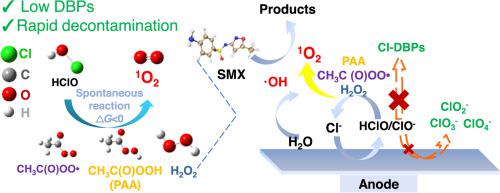当前位置:
X-MOL 学术
›
Water Res.
›
论文详情
Our official English website, www.x-mol.net, welcomes your
feedback! (Note: you will need to create a separate account there.)
Exploring the viability of peracetic acid-mediated antibiotic degradation in wastewater through activation with electrogenerated HClO
Water Research ( IF 11.4 ) Pub Date : 2024-06-28 , DOI: 10.1016/j.watres.2024.122007 Wang Lu 1 , Nan Chen 2 , Chuanping Feng 2 , Ignasi Sirés 3 , Ning An 2 , Haotian Mu 2
Water Research ( IF 11.4 ) Pub Date : 2024-06-28 , DOI: 10.1016/j.watres.2024.122007 Wang Lu 1 , Nan Chen 2 , Chuanping Feng 2 , Ignasi Sirés 3 , Ning An 2 , Haotian Mu 2
Affiliation

|
Electrochemical advanced oxidation processes (EAOPs) face challenging conditions in chloride media, owing to the co-generation of undesirable Cl−disinfection byproducts (Cl−DBPs). Herein, the synergistic activation between in-situ electrogenerated HClO and peracetic acid (PAA)-based reactive species in actual wastewater is discussed. A metal-free graphene−modified graphite felt (graphene/GF) cathode is used for the first time to achieve the electrochemically-mediated activation of PAA. The PAA/Cl− system allowed a near−complete sulfamethoxazole (SMX) degradation (k obs =0.49 min−1 ) in only 5 min in a model solution, inducing 32.7− and 8.2−fold rise in k obs as compared to single PAA and Cl− systems, respectively. Such enhancement is attributed to the occurrence of 1 O2 (25.5 μmol L−1 after 5 min of electrolysis) from the thermodynamically favored reaction between HClO and PAA-based reactive species. The antibiotic degradation in a complex water matrix was further considered. The SMX removal is slightly susceptible to the coexisting natural organic matter, with both the acute cytotoxicity (ACT) and the yield of 12 DBPs decreasing by 29.4 % and 37.3 %, respectively. According to calculations, HClO accumulation and organic Cl−addition reactions are thermodynamically unfavored. This study provides a scenario-oriented paradigm for PAA−based electrochemical treatment technology, being particularly appealing for treating wastewater rich in Cl− ion, which may derive in toxic Cl−DBPs.
中文翻译:

通过电生 HClO 活化探索废水中过乙酸介导的抗生素降解的可行性
由于同时产生不需要的 Cl−消毒副产物 (Cl−DBP),电化学高级氧化过程 (EAOP) 在氯化物介质中面临着挑战性的条件。本文讨论了实际废水中原位电生成 HClO 和过乙酸 (PAA) 基活性物质之间的协同活化作用。首次使用无金属石墨烯改性石墨毡(石墨烯/GF)阴极来实现 PAA 的电化学介导活化。 PAA/Cl− 系统在模型溶液中仅用 5 分钟即可实现近乎完全的磺胺甲恶唑 (SMX) 降解 (kobs =0.49 min−1),与单一 PAA 和 Cl 相比,kobs 增加了 32.7− 和 8.2− 倍− 系统。这种增强归因于 HClO 和基于 PAA 的活性物质之间热力学有利的反应产生 1O2(电解 5 分钟后为 25.5 μmol L−1)。进一步考虑了复杂水基质中抗生素的降解。 SMX的去除对共存的天然有机物稍微敏感,急性细胞毒性(ACT)和12 DBP的产量分别下降29.4%和37.3%。根据计算,HClO积累和有机Cl−加成反应在热力学上是不利的。这项研究为基于 PAA 的电化学处理技术提供了一个面向场景的范例,对于处理富含 Cl- 离子的废水特别有吸引力,这些废水可能会产生有毒的 Cl-DBP。
更新日期:2024-06-28
中文翻译:

通过电生 HClO 活化探索废水中过乙酸介导的抗生素降解的可行性
由于同时产生不需要的 Cl−消毒副产物 (Cl−DBP),电化学高级氧化过程 (EAOP) 在氯化物介质中面临着挑战性的条件。本文讨论了实际废水中原位电生成 HClO 和过乙酸 (PAA) 基活性物质之间的协同活化作用。首次使用无金属石墨烯改性石墨毡(石墨烯/GF)阴极来实现 PAA 的电化学介导活化。 PAA/Cl− 系统在模型溶液中仅用 5 分钟即可实现近乎完全的磺胺甲恶唑 (SMX) 降解 (kobs =0.49 min−1),与单一 PAA 和 Cl 相比,kobs 增加了 32.7− 和 8.2− 倍− 系统。这种增强归因于 HClO 和基于 PAA 的活性物质之间热力学有利的反应产生 1O2(电解 5 分钟后为 25.5 μmol L−1)。进一步考虑了复杂水基质中抗生素的降解。 SMX的去除对共存的天然有机物稍微敏感,急性细胞毒性(ACT)和12 DBP的产量分别下降29.4%和37.3%。根据计算,HClO积累和有机Cl−加成反应在热力学上是不利的。这项研究为基于 PAA 的电化学处理技术提供了一个面向场景的范例,对于处理富含 Cl- 离子的废水特别有吸引力,这些废水可能会产生有毒的 Cl-DBP。











































 京公网安备 11010802027423号
京公网安备 11010802027423号